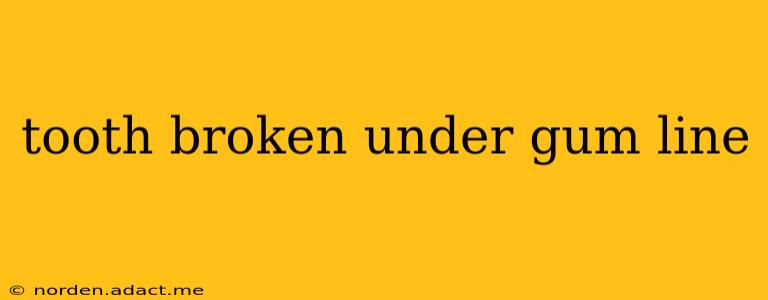A broken tooth under the gum line is a serious dental emergency requiring prompt professional attention. This situation often presents unique challenges due to the limited visibility and access to the affected area. Understanding the causes, diagnosis, treatment options, and preventive measures is crucial for preserving your oral health.
What Causes a Tooth to Break Under the Gum Line?
Several factors can contribute to a tooth fracturing below the gum line. These often involve significant trauma or underlying weakening of the tooth structure.
- Trauma: A significant blow to the mouth, such as from a sports injury or a fall, can fracture a tooth, sometimes below the gum line. This is a common cause, especially in contact sports.
- Decay: Extensive tooth decay can weaken the tooth structure, making it susceptible to fracture, even under relatively minor stress. Untreated cavities can progress to the point of compromising the tooth's integrity below the gum line.
- Bruxism (Teeth Grinding): Chronic teeth grinding, often unconscious, places significant stress on the teeth, eventually leading to fractures. This can gradually weaken the tooth structure, making it prone to breakage below the gum line.
- Gum Disease (Periodontitis): Severe gum disease can lead to bone loss around the teeth, making them more vulnerable to fractures. The supporting structures weaken, leaving the teeth less stable and more easily damaged.
How is a Broken Tooth Under the Gum Line Diagnosed?
Diagnosing a broken tooth beneath the gum line requires a thorough examination by a dentist. They will use several methods to assess the damage:
- Visual Examination: While the fracture might not be directly visible, the dentist will examine the gum tissue and surrounding area for signs of inflammation, swelling, or discoloration.
- X-rays: Dental X-rays are essential for visualizing the extent of the fracture. These images clearly reveal the location and severity of the break, enabling the dentist to develop an appropriate treatment plan.
- Dental Probes: The dentist might use small, specialized probes to gently explore the area and detect irregularities or sensitivity indicative of a fracture.
What are the Treatment Options for a Broken Tooth Under the Gum Line?
The treatment for a tooth broken beneath the gum line depends on several factors, including the extent of the damage, the health of the tooth, and the overall oral health of the patient. Options include:
- Root Canal Treatment: If the fracture extends into the pulp (the inner part of the tooth containing nerves and blood vessels), a root canal is typically required to remove the infected pulp and prevent further damage. This is often followed by a crown or other restoration.
- Extraction: In cases of severe damage or extensive decay, extraction might be necessary. This involves removing the tooth completely. Following extraction, the dentist might recommend a dental implant, bridge, or denture to replace the missing tooth.
- Crown: If the tooth structure is sufficiently sound, a crown (a cap that covers the entire tooth) can be placed to protect and restore the tooth's function and aesthetics. Sometimes, a post and core buildup is necessary to support the crown.
Can a Broken Tooth Under the Gum Line Be Prevented?
While accidents cannot always be avoided, several steps can significantly reduce the risk of a tooth breaking below the gum line:
- Good Oral Hygiene: Regular brushing and flossing remove plaque and tartar, preventing tooth decay and gum disease, which weaken the teeth and make them more vulnerable to fractures.
- Regular Dental Checkups: Regular visits to the dentist allow for early detection and treatment of cavities and gum disease, reducing the risk of tooth breakage.
- Mouthguard Use: Wearing a mouthguard during contact sports and other activities where impact to the mouth is possible significantly reduces the risk of trauma-related tooth fractures.
- Stress Management: If you suffer from bruxism (teeth grinding), stress management techniques and a custom-fitted nightguard can help reduce the grinding and protect your teeth.
What Happens if a Broken Tooth Under the Gum Line is Left Untreated?
Ignoring a broken tooth under the gum line can lead to several serious complications:
- Infection: The exposed pulp becomes vulnerable to infection, which can spread to the surrounding tissues and bone, leading to abscesses and significant pain.
- Tooth Loss: Untreated fractures can weaken the tooth to the point of complete breakage or loss.
- Bone Loss: Infection and inflammation can result in bone loss around the tooth, further compromising its stability.
In conclusion, a broken tooth beneath the gum line necessitates immediate professional attention. Prompt diagnosis and treatment are crucial to prevent further complications and preserve your oral health. Regular dental checkups and preventative measures play a vital role in safeguarding your smile.
